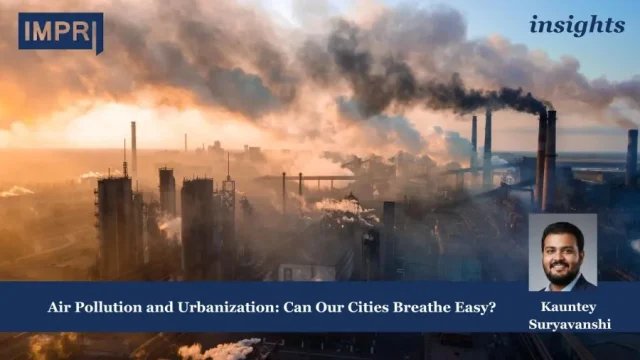Kauntey Suryavanshi
Cities have always been magnets of opportunity. They promise jobs, better healthcare, and vibrant lifestyles. But as our skylines rise higher, so does the invisible cloud of pollutants choking the very air we breathe. The connection between urbanization and air pollution is one of the biggest challenges of our time. And with more than half of the world’s population now living in cities, this is not just an environmental issue, it’s a human survival issue.
Why Urbanization Fuels Air Pollution
Urbanization itself is not the enemy. Cities drive economies, foster innovation, and connect communities. The problem is unchecked urban growth, crowded housing, endless construction, traffic congestion, and industries packed into tight spaces.
- Vehicles: Rising car ownership adds massive amounts of nitrogen oxides and particulate matter to city air.
- Industries: Factories and power plants release sulfur dioxide, carbon monoxide, and volatile organic compounds.
- Energy demand: More people mean more electricity, often generated from fossil fuels.
- Construction dust: Expanding roads, buildings, and infrastructure create suspended dust particles.
The result: A dangerous cocktail of PM2.5, PM10, SO₂, NOx, and other pollutants lingering over urban skies.
Health at Risk: When Breathing Becomes a Hazard
Imagine walking to work and unknowingly inhaling fine particles that slip past your body’s natural defenses and lodge deep into your lungs. That’s the daily reality in many cities.
- Respiratory problems: Asthma, chronic bronchitis, and lung infections are increasingly common.
- Heart diseases: Prolonged exposure raises risks of strokes and heart attacks.
- Children and elderly: The most vulnerable suffer the most, with stunted lung development in kids and worsened conditions in seniors.
The World Health Organization estimates that 7 million premature deaths each year are linked to poor air quality. That’s not a statistic, it’s a tragedy playing out in families, especially in countries like India, where cities such as Delhi frequently rank among the most polluted on the planet.
Environmental and Social Costs
Polluted air doesn’t stop at health—it changes the way our cities function.
- Climate change accelerates: Black carbon and other pollutants trap heat, disrupting weather cycles.
- Urban heat islands: Cities become several degrees hotter than nearby rural areas, worsening heatwaves.
- Inequality deepens: Low-income families often live near highways or industrial belts, meaning they breathe the worst air.
This makes air pollution not only an environmental crisis but also a social justice issue.
Are Policies and Technologies Helping?
Thankfully, there’s no shortage of solutions, though their success varies.
- Stricter emission norms: India’s BS-VI vehicle standards, Europe’s Euro 6, and similar regulations push industries to clean up.
- Public transport and EVs: Metro systems, electric buses, and incentives for electric cars reduce vehicle emissions.
- Air quality monitoring: Network of sensors now give citizens real-time data about the air they breathe.
- Urban greening: Cities like Singapore show how green corridors, rooftop gardens, and urban forests can cool temperatures and absorb pollutants.
Case in point: Beijing cut PM2.5 levels by over 35% between 2013–2017 through strict regulations, relocation of industries, and heavy investment in clean energy. London’s Ultra Low Emission Zone (ULEZ) is another example, where restricting polluting cars is already improving air quality.
The Roadblocks We Still Face
Despite progress, several gaps persist:
- Weak enforcement: Policies look good on paper but often fail in practice.
- Multiple agencies, little coordination: Urban air management gets stuck between city councils, pollution boards, and transport departments.
- Economic fears: Governments hesitate to regulate industries strictly, fearing job losses.
- Public awareness: Many people don’t realize how much small lifestyle changes, carpooling, reducing waste burning, planting trees can help.
The Way Forward: Building Breathable Cities
If we want future generations to breathe freely, we must design cities differently.
- Smarter urban planning – Compact, mixed-use neighborhoods reduce commuting distances.
- Clean energy transitions – Solar rooftops, wind farms, and decentralized grids should replace coal.
- Green infrastructure – More parks, green belts, and green roofs to naturally filter air.
- Citizen power – Apps and platforms to track air quality, report violations, and encourage cleaner lifestyles.
- Global cooperation – Cities must share best practices across borders. Pollution does not recognize boundaries.
Conclusion: A City’s True Prosperity
Air pollution is often called an “invisible killer”, but anyone living in a smog-covered city knows it’s all too visible. What’s important now is changing our mindset: economic growth and clean air are not competing goals; they must go hand in hand.
The future of urbanization lies in balance: skyscrapers alongside green roofs, metros alongside cycle lanes, and industries powered by clean energy. A truly prosperous city is not just one that shines at night, it’s one where its people can take a deep breath of fresh air during the day.
About the contributor: Kauntey Suryavanshi is an urban development professional, passionate about making cities cleaner, greener, and more resilient. He is a fellow of DFPGYF Diplomacy, Foreign Policy & Geopolitics Youth Fellowship- Cohort 2.0.
Disclaimer: All views expressed in the article belong solely to the author and not necessarily to the organisation.
Read more at IMPRI:
Mozambique’s Maritime Role in the Indo-Pacific and India’s Resilience Diplomacy
India-UAE CEPA 2022: Unlocking New Horizons for MSME Exports
Acknowledgement: This article was posted by Shivashish Narayan, a visiting researcher at IMPRI.



















